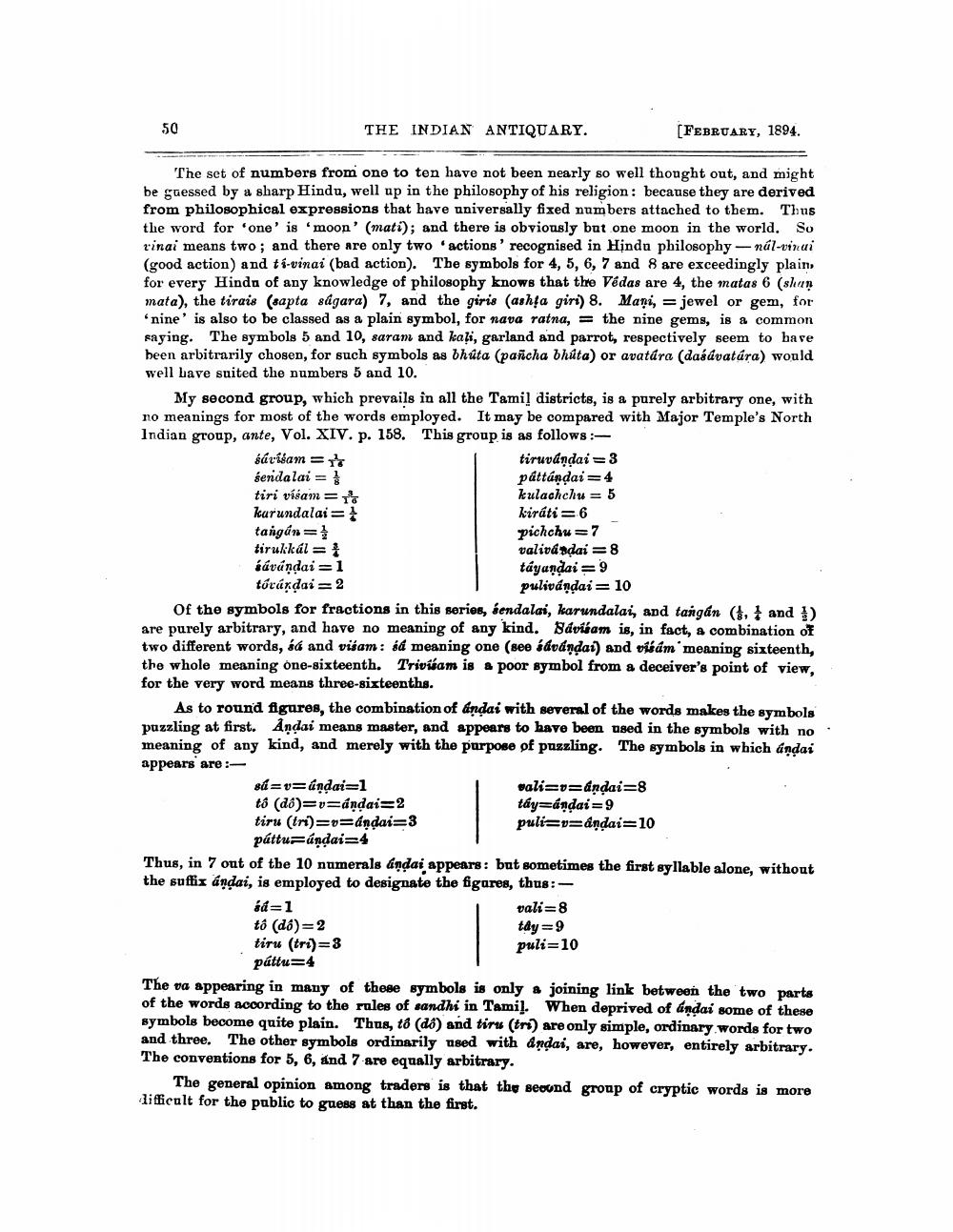________________
50
THE INDIAN ANTIQUARY.
[FEBRUARY, 1894.
The set of numbers from one to ten have not been nearly so well thought out, and might be guessed by a sharp Hindu, well up in the philosophy of his religion: because they are derived from philosophical expressions that have universally fixed numbers attached to them. Thus the word for 'one' is 'moon' (matí); and there is obviously but one moon in the world. So rinai means two; and there are only two 'actions' recognised in Hindu philosophy - nál-vinui (good action) and ts-vinai (bad action). The symbols for 4, 5, 6, 7 and 8 are exceedingly plain, for every Hinda of any knowledge of philosophy knows that the Vedas are 4, the matas 6 (shan mata), the tirais (sapta sågara) 7, and the giris (ashļa giri) 8. Mani, = jewel or gem, for
nine' is also to be classed as a plain symbol, for nava ratna, = the nine gems, is a common saying. The symbols 5 and 10, saram and kali, garland and parrot, respectively seem to have been arbitrarily chosen, for such symbols as Bhúta (pañcha bhita) or avatdra (dasávatára) would well bave suited the numbers 5 and 10.
My second group, which prevails in all the Tamil districts, is a purely arbitrary one, with no meanings for most of the words employed. It may be compared with Major Temple's North Indian group, ante, Vol. XIV. p. 158. This group is as follows: śávisam = 1
tiruvándai= 3 sendalai = 1
páttándai=4 tiri visam = 1
kulachchu = 5 kurundalai=
kiráti = 6 tangán=1
pichchu=7 tirukkál = t
valivárdai = 8 kávándai = 1
tayandai= 9 tórárdai = 2
pulivandai= 10 Of the symbols for fractions in this series, áendalai, karundalai, and tangán (#, and ) are purely arbitrary, and have no meaning of any kind. Sdvicam is, in fact, a combination of two different words, sá and visam: ód meaning one (see kávándat) and vibám meaning sixteenth, the whole meaning one-sixteenth. Trivíam is a poor symbol from a deceiver's point of view, for the very word means three-sixteenths.
As to round figures, the combination of andai with several of the words makes the symbols pazzling at first. Andai means master, and appears to have been used in the symbols with no meaning of any kind, and merely with the purpose of puzzling. The symbols in which andai appears are : sú=v=undai=1
wali=p=andai=8 tô (db)=y=andai=2
tay=andai=9 tiru (tr)=r=andai=3
puli=p=andai=10 pátturándai=4 Thus, in 7 out of the 10 numerals andai appears: but sometimes the first syllable alone, without the suffix andai, is employed to designate the figures, thus:ád=1
vali=8 tó (db)=2
täy=9 tiru (tri)=3
puli=10 páttu=4 The va appearing in many of these symbols is only a joining link between the two parts of the words according to the rules of sandhi in Tamil. When deprived of andai some of these symbols become quite plain. Thus, t8 (dő) and tirs (tr) are only simple, ordinary words for two and three. The other symbols ordinarily used with andai, are, however, entirely arbitrary. The conventions for 5, 6, and 7-are equally arbitrary.
The general opinion among traders is that the second group of cryptic words is more difficult for the public to guess at than the first.




